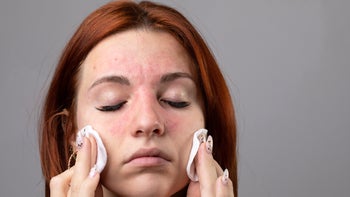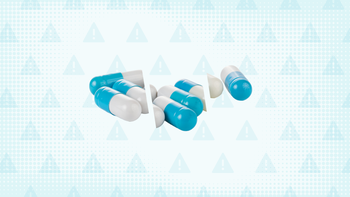Doxycycline for Acne: The Essential Guide
Key takeaways:
Doxycycline is a common antibiotic that healthcare professionals prescribe for acne.
It works by killing acne-causing bacteria and lowering inflammation.
Bacteria on the skin’s surface can become resistant to antibiotics. So, it’s best to limit using doxycycline for acne to no more than 3 to 4 months.
Access savings on related medications
Table of contents

Acne can be stubborn and frustrating to treat. If you’ve been to the dermatologist (skin specialist), you may have heard of — or even been prescribed — doxycycline as part of a skin-care regimen.
Doxycycline is a popular treatment option for acne, so let’s talk about what you should know while taking it.
What is doxycycline?
Doxycycline is an antibiotic, meaning it’s a medication used to kill bacteria. It belongs to a group, or class, of antibiotics known as tetracyclines. Two other medications in this class include tetracycline and minocycline.
Search and compare options
Experts don’t know for sure yet if one antibiotic works better than the other, but a healthcare professional will work with you to find the best treatment. Minocycline and doxycycline usually cause fewer side effects (like an upset stomach) and don’t have to be taken as often. So, they’re prescribed more commonly than tetracycline.
Generic versions of doxycycline include doxycycline hyclate and doxycycline monohydrate. Some brand names include:
Vibra-Tab
Doryx
Oracea
How does doxycycline work for acne?
Doxycycline treats acne by killing off bacteria on the skin, so the bacteria can’t cause inflammation. Doxycycline also improves acne by lowering inflammation in the skin.
It’s normal to have bacteria on the skin — everyone does. In fact, there are around 1,000 types of bacteria that reside on your skin. Many times, these bacteria don’t cause any trouble. But, from puberty onward, the bacteria that live in the skin’s pores can be problematic at times. That’s because oil glands start producing more oil around the time of puberty.
When extra oil in the pores mixes with bacteria and dead skin cells, it clogs pores and causes inflammation (acne) in the surrounding skin. And that’s why doxycycline’s antibiotic and anti-inflammatory actions help combat acne.
What type of acne do you have? Learn about three common types of acne (with pictures) and the best ways to treat them.
Managing acne scars: Read what treatments worked for four women living with acne scars.
Getting rid of pimples fast: From over-the-counter products to at-home treatments, learn the best ways to get rid of pimples fast.
How long does it take doxycycline to start working for acne?
Like other acne treatments, doxycycline needs some time to start working. Acne might start improving within 2 weeks. But it can take up to 12 weeks (3 months) to see the full benefit of the treatment.
You’ll know doxycycline is working for you when you see less acne forming and your skin starts to look clearer. Many treatments can make your skin look worse when you first start them. But this is generally not an issue with doxycycline.
How long do you need to take doxycycline?
Dermatologists often limit doxycycline treatment to 3 months. This is to prevent Cutibacterium acnes from becoming resistant to doxycycline (meaning the medication no longer kills the bacteria). But everyone responds differently, and your prescriber might want you to use it longer.
Healthcare professionals usually prescribe doxycycline combined with other treatments — mainly topical treatments, like retinoid creams or benzoyl peroxide. This is so you still have a treatment option that’ll stop your acne from coming back after you stop taking doxycycline. Benzoyl peroxide also works by killing bacteria, so using it with doxycycline helps prevent antibiotic resistance.
If your dermatologist prescribed doxycycline and another medication for you to use at the same time, it’s important to follow their instructions to get the best results.
What’s the best way to take doxycycline?
Doxycycline comes in a tablet or capsule that you take by mouth with a full glass of water. Below are some general tips for taking doxycycline. However, be sure to check with your prescriber or pharmacist to find out the best way to take it.
Tips for taking doxycycline:
Take doxycycline with food. Since doxycycline can cause nausea, taking it with food can help. However, some forms of doxycycline, like Oracea (doxycycline 40 mg), should only be taken on an empty stomach so your body can fully absorb it. So, be sure to follow your prescriber’s instructions.
Avoid dairy products and certain supplements right before and after taking doxycycline. Don’t consume dairy products or take calcium or iron supplements within 1 hour before or 2 hours after taking doxycycline. Dairy products and other foods or supplements high in calcium or iron can prevent your body from absorbing doxycycline. The key is to plan ahead. So, let your prescriber or pharmacist know about any supplements you might be taking.
Doxycycline dosage
Here are some typical dosages of doxycycline for acne. Your dermatologist may use one of these or a different dosage, depending on your situation:
20 mg twice a day
40 mg once a day
50 mg twice a day
100 mg once a day
100 mg twice a day
What are common side effects of doxycycline?
Most people do well on doxycycline. But, like all medications, doxycycline can cause side effects.
The most common doxycycline side effects are:
Sun sensitivity (getting burned more easily in the sun): Protect yourself in the sun while taking doxycycline by wearing sunscreen and finding a well-shaded spot. It’s also helpful to wear protective clothing, a hat, and sunglasses.
Nausea, vomiting, or diarrhea: Depending on the type of doxycycline, your prescriber may recommend that you take it with food or switch to a different medication to avoid these side effects. Once you stop taking doxycycline, your stomach will likely feel better within a few days.
Esophagitis (inflammation of the esophagus): The esophagus is the tube that connects the mouth to the stomach. Esophagitis is a condition that can feel like heartburn. It might cause pain when you swallow. You can prevent esophagitis by not lying down for at least 30 minutes after taking doxycycline.
Rare side effects of doxycycline include:
Permanent yellow staining of teeth: Children shouldn’t take doxycycline because it can permanently stain their teeth. If you’re pregnant, taking doxycycline can affect the fetus’s developing teeth, causing yellow or brown discoloration. So, taking this medication isn’t recommended during pregnancy. However, in some cases, doxycycline may be taken for certain infections.
Stevens-Johnson syndrome (SJS) or toxic epidermal necrolysis (TEN): SJS and TEN are very-rare-but-serious immune reactions, usually caused by medication, such as doxycycline. Symptoms start appearing 1 to 3 weeks after starting the medication and can include a rash (usually on the face, neck, or upper torso). Other signs may include fever, headache, or coughing. If you think you might be having these symptoms, call 911 or get medical help right away.
How long do doxycycline side effects last?
Remember, most of the common side effects of doxycycline will get better soon after you stop taking it. Here’s what to expect:
Nausea, vomiting, and diarrhea: Symptoms like nausea, vomiting, and diarrhea should get better within a few days of stopping doxycycline.
Sun sensitivity: Sun sensitivity can last for about 10 to 14 days after you stop taking it.
Esophagitis: Esophagitis usually gets better within 1 to 2 weeks of stopping the medication — sometimes even sooner.
Can doxycycline interact with any other medications?
The following over-the-counter (OTC) medications may make doxycycline less effective by blocking how much of it you absorb:
Calcium-containing antacids, like calcium carbonate (Tums)
Bismuth subsalicylate (Pepto-Bismol, Kaopectate)
Aluminum- and magnesium-containing products (milk of magnesia, Mylanta, and some multivitamins)
These prescription medications can also interact with doxycycline:
Warfarin: Warfarin (Coumadin) is a popular blood thinner. When taken together, doxycycline can make the effects of warfarin more intense. You’ll need to keep a close eye on your warfarin levels (known as international normalized ratio, or INR) while taking doxycycline.
Seizure medications: Some seizure medications (like phenytoin and phenobarbital, for example) might make your doxycycline less effective.
This isn’t a complete list of all the medications and supplements that can interact with doxycycline. Make sure your prescriber and pharmacist are aware of all the medications you’re taking, including OTC and herbal medications. That way they can check if doxycycline is safe for you.
What if doxycycline makes your acne worse?
Doxycycline shouldn’t make your acne worse before it gets better. If your breakouts get worse with doxycycline, you should ask aboutother acne treatment options.
Your dermatologist might change your topical medication (medication that’s applied to skin) or recommend:
A different antibiotic
How to save on doxycycline for acne
Doxycycline hyclate and doxycycline monohydrate have similar effects. They’re about equally prescribed, and most private insurance and Medicare plans cover both.
No matter which type of doxycycline you use, there are many ways to save:
GoodRx coupons: Using GoodRx can help you save up to 90% of the average retail price of generic doxycycline. At some pharmacies, generic doxycycline hyclate and doxycycline monohydrate are each about $10 with the GoodRx discount.
Mail-order pharmacy: Check with your insurance plan to see if they offer discounts by using their mail-order pharmacy.
Copay savings card: For people with private insurance who meet certain requirements, manufacturer’s savings cards can mean big savings. For example,brand name doxycycline, like Oracea and Doryx MPC, can both be as low as $0 with the manufacturers’ savings cards.
Patient assistance programs: People who are uninsured or underinsured may be eligible for Oracea’s patient assistance program. This can help you get doxycycline free of cost.
Different types of doxycycline: If you’re prescribed doxycycline hyclate or monohydrate, you can always ask your pharmacist to swap your prescription if one price is better. They’ll likely call your prescriber to confirm whether that’s OK.
What are some alternatives to doxycycline?
Doxycycline is a popular acne medication, but it’s not for everyone. When it comes to antibiotics for acne, the American Academy of Dermatology also recommends:
In addition to antibiotics, there are other treatments available. These include topical medications, hormonal treatments, andisotretinoin (Accutane).
With all of the treatment recommendations out there for acne, don’t forget that healthcare professionals are there for you. Your prescriber can help with managing side effects or figuring out your insurance coverage.
Frequently asked questions
If you’re just taking doxycycline for your acne, it’s possible that your acne will return after you stop taking it. Doxycycline helps lower inflammation and kills acne-causing bacteria, but it’s not a long-term treatment. That’s why healthcare professionals often prescribe it along with topical retinoids for long-term use.
Purging is when your acne gets worse after starting your treatment, and it’s not really common with doxycycline (or other antibiotic pills). It’s much more likely to happen with topical retinoids, which are often combined with doxycycline. Purging with topical retinoids usually happens during the first few weeks after starting it.
Yes, doxycycline can help treat hormonal acne. It’s usually used for a few months in combination with other more long-term treatments. This usually includes hormonal treatments, like birth control pills or spironolactone.
The bottom line
Doxycycline is an antibiotic commonly prescribed for short-term acne treatment. It works to kill acne-causing bacteria and lower inflammation. The most common side effects are sun sensitivity and nausea. Since bacteria can become resistant, you won’t typically take doxycycline for longer than 3 to 4 months. If your acne doesn’t get better, talk with a healthcare professional about other acne treatment options.
Why trust our experts?



References
American Academy of Dermatology Association. (n.d.). Acne clinical guideline.
Dutil, M. (2010). Benzoyl peroxide: Enhancing antibiotic efficacy in acne management. Skin Therapy Letter.
Eisenstein, M. (2020). The skin microbiome. Nature.
Galderma Laboratories. (2014). Oracea (doxycycline) capsules for oral use [package insert].
Goetze, S., et al. (2017). Phototoxicity of doxycycline: A systematic review on clinical manifestations, frequency, cofactors, and prevention. Skin Pharmacology and Physiology.
Gold, L., et al. (2010). Effective and safe combination therapy for severe acne vulgaris: A randomized, vehicle-controlled, double-blind study of adapalene 0.1%-benzoyl peroxide 2.5% fixed-dose combination gel with doxycycline hyclate 100 mg. Cutis.
Kikendall, J. W. (2007). Pill-induced esophagitis. Gastroenterology and Hepatology.
Kircik, L. H. (2010). Doxycycline and minocycline for the management of acne: A review of efficacy and safety with emphasis on clinical implications. Journal of Drugs in Dermatology.
MedlinePlus. (2024). Doxycycline.
Oracea. (n.d.). Patient savings.
Rosso, J. Q. D. (2015). Oral doxycycline in the management of acne vulgaris: Current perspectives on clinical use and recent findings with a new double-scored small tablet formulation. Journal of Clinical and Aesthetic Dermatology.
Saleem, F., et al. (2023). Drug-induced esophagitis. StatPearls.
Shutter, M.C., et al. (2023). Tetracycline. StatPearls.

























